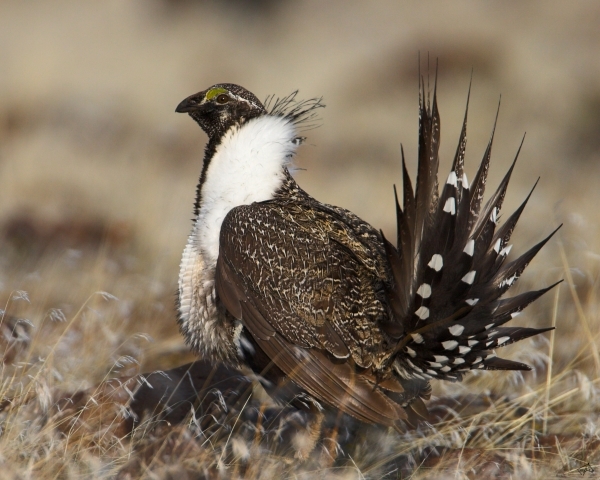Partnerships keep sage grouse off endangered list
The greater sage grouse will not be added to the endangered species list because the bird's habitat in Nevada and 10 other western states is already being protected by "the largest land conservation effort in U.S. history."
So said Interior Secretary Sally Jewell in an announcement Tuesday that was immediately cheered by some who feared red tape and economic damage from an endangered species listing for such a wide-ranging bird.
Jewell said additional federal protection is unnecessary thanks to all the work done so far: dozens of public-private partnerships among federal and state regulators, ranchers, energy developers and conservationists aimed at preserving the chicken-sized bird's sagebrush home.
"The U.S. Fish & Wildlife Service has determined that these collective efforts add up to a bright future for the sage grouse," Jewell said in a video posted to YouTube.
Two hours later, she formally announced the final listing decision for the sage grouse at Rocky Mountain Arsenal National Wildlife Refuge just outside Denver, where she was joined by a host of federal and state officials including Nevada Gov. Brian Sandoval and the governors of Colorado, Montana and Wyoming.
Sandoval said he is "cautiously optimistic that this is good news for Nevada," but a lot more work lies ahead.
"I appreciate Secretary Jewell's commitment to continue working with us, and I take her at her word that we will collaborate in good faith during the next two years so that we have the opportunity to demonstrate that the Nevada plan provides the best conservation for sage-grouse in Nevada," Sandoval said in a written statement. "We will closely monitor the implementation of this decision so that every option remains available to our state."
The greater sage grouse is native to 11 western states and Canada, but its population has declined over the past century from about 16 million to fewer than 500,000 by some estimates.
The ground-dwelling bird measures up to 30 inches long and two feet tall and weighs two to seven pounds. In the spring, the males puff themselves up and perform elaborate mating dances that attract hens and human tourists.
Experts say the bird is now threatened with extinction because its fragile, slow-healing sagebrush habitat has been splintered by wildfires, invasive plants and human development. In Nevada alone, wildfires have burned through more than 800,000 acres of sagebrush since 2000.
Jewell called it "death by a thousand cuts."
Sage grouse are found across the northern half of Nevada, with large expanses of prime habitat in the northeastern and northwestern corners of the state. Several hundred of the birds are killed in Nevada each year in state-regulated hunts that have gone on for decades.
Jewell called the proactive approach to saving the sage grouse "a milestone for conservation in America" that will benefit everyone in the long run.
"A healthy sagebrush landscape also supports a healthy western economy for ranching, outdoor recreation and energy that powers our nation," she said.
But not everyone is celebrating.
Sen. Dean Heller, R-Nev., said the federal mitigation plans drawn up to avoid listing the sage grouse are just as damaging to Nevada and the West.
"This has been an issue of the Department of the Interior using the threat of a listing to get what it really wanted all along: limiting Nevadans' access to millions of acres of land equal to the size of the state of West Virginia," Heller said in a written statement. "At the end of the day, Big Government continues to tighten its grip at the expense of rural America's future, especially in Nevada."
Rep. Rob Bishop, a Utah Republican and chairman of the House Committee on Natural Resources, called Tuesday's announcement "a cynical ploy" to distract the public from federal regulation every bit as restrictive as listing would have been.
"The new command and control federal plan will not help the bird, but it will control the West, which is the real goal of the Obama Administration," Bishop said in a written statement.
Technically, there are almost 100 separate plans.
The Fish & Wildlife Service and the Bureau of Land Management gave final approval Tuesday to 98 land-use plans developed by federal, state and local stakeholders over the past five years to protect sagebrush habitat on public land in 11 states.
According to agency officials, those plans are generally designed to minimize new surface disturbances in core sage grouse areas, improve and expand existing habitat and reduce the threat of wildfires, all while respecting valid rights and rights-of-way.
But some new development will be restricted because of the bird. The Department of Interior just announced plans to temporarily prohibit new mines on about 10 million acres of federal land considered sage grouse strongholds in Nevada, Idaho, Montana, Oregon, Utah and Wyoming.
The ban on new mining development is expected to last for up to two years while federal regulators determine whether the land should be permanently withdrawn from mineral exploration to protect sage grouse. That analysis will include input from the public.
For now, the decision not to list the bird is largely drawing praise — though some of it guarded — from ranchers, hunting organizations, energy developers and conservation groups.
Eric Holst, associate vice president of working lands for the Environmental Defense Fund, called it "one of the biggest listing decisions of our time" and proof that "wildlife conservation does not have to come at the expense of the economy."
Contact Henry Brean at hbrean@reviewjournal.com or 702-383-0350. Find him on Twitter: @RefriedBrean






















